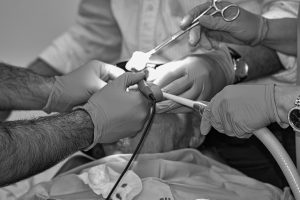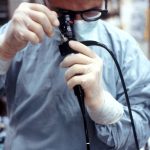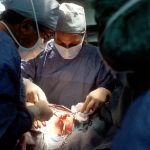InView Imaging: Safe and Gentle Biopsies
A biopsy is a critical diagnostic procedure where a small sample of tissue is removed from the body for examination under a microscope. It is often used to diagnose conditions such as cancer, infections, and inflammatory diseases. At InView Imaging, we understand that undergoing a biopsy can be a stressful experience, and we are committed to providing you with the highest level of care and support throughout the process.
Our radiologists perform hundreds of biopsies each year, bringing a wealth of expertise and proficiency to every procedure. Additionally, our doctors use state-of-the-art technology to ensure precise and accurate results, making your biopsy as safe and effective as possible
We are proud to offer biopsy services at our convenient locations in Antioch, Oakland, and Fremont, with services coming soon to San Ramon. This accessibility ensures that you can receive the care you need close to home. Additionally, we accept most insurance plans, making our services both accessible and affordable.
Choosing InView Imaging means choosing a team that genuinely cares about your health and well-being. Our skilled radiologists and friendly staff are here to guide you through every step of the biopsy process, ensuring your comfort and peace of mind. Schedule your biopsy at any of our locations today and experience the InView difference—exceptional care with a personal touch.

Considering a biopsy but unsure about the procedure? Biopsy, a common medical test, involves extracting tissue samples for examination. While it may sound intimidating, biopsy procedures, including surgical and incisional biopsies, are crucial in diagnosing various conditions with precision using biopsy samples. From detecting cancer to identifying infections or inflammatory diseases, biopsy procedures provide vital insights for accurate treatment plans. Whether it’s a needle biopsy or surgical procedure, understanding the process and its significance is essential for informed healthcare decisions. Stay tuned as we delve into the intricacies of biopsies, debunk myths surrounding the procedure, and explore why this diagnostic tool is indispensable in modern medicine.
Biopsy Basics
Definition
A biopsy is a medical procedure that involves removing a small sample of tissue, often from a tumor, for examination. This diagnostic technique, including biopsy procedures and imaging, helps in identifying various health conditions, including cancer. Different types of biopsy procedures, such as needle, endoscopic, and skin biopsies, cater to specific areas and purposes.
Importance
Biopsy plays a crucial role in determining the nature of abnormal tissue growth, tumor, cancer, cells within the body. By analyzing biopsy results, healthcare professionals can make informed decisions regarding treatment strategies for patients with different medical conditions. The significance of biopsy lies in its ability to aid in early disease detection, provide accurate diagnoses, and help health care providers and doctors identify cancer cells.
Procedure Overview
The process of biopsy begins with the extraction of a small tissue sample from the affected area using specialized tools or techniques. This sample is then sent to a laboratory for detailed analysis by pathologists. The key steps involved in performing a biopsy include preparing the patient, administering local anesthesia, extracting the tissue sample precisely, and ensuring proper handling and storage for analysis.
Healthcare professionals such as doctors, surgeons, or radiologists are responsible for conducting biopsies based on their specialization and expertise in cells and cancer. These professionals, including the doctor, work collaboratively to ensure that the biopsy procedure is carried out safely and accurately to obtain reliable results that assist in diagnosing various health conditions effectively.
Types of Biopsies
Needle Biopsy
Needle biopsy is a minimally invasive procedure where a thin needle extracts tissue for examination. This technique offers quick recovery and leaves minimal scarring, making it favorable for patients. Common areas for needle biopsies include the breast and lung, aiding in the diagnosis of various conditions.
Endoscopic Biopsy
Endoscopic biopsy involves using a flexible tube with a camera to collect tissue samples from internal organs. This method allows healthcare providers to access internal structures without resorting to surgery, reducing risks and promoting faster recovery. Endoscopic biopsy is commonly utilized in diagnosing gastrointestinal disorders, providing accurate insights into the underlying issues.
Pros:
Minimally invasive
Accurate diagnosis
Skin Biopsy
Skin biopsy is crucial for examining skin lesions or abnormalities by extracting tissue samples from the affected area. Various techniques like shave biopsy or punch biopsy are employed based on the specific requirements of each case. It plays a vital role in diagnosing skin cancers, dermatological conditions, and monitoring treatment effectiveness.
Cons:
Potential discomfort
Risk of infection
Bone Marrow Biopsy
Bone marrow biopsy entails collecting bone marrow tissue to analyze blood disorders and cancers accurately. While this procedure can be uncomfortable, it provides essential information critical for diagnosing various hematologic conditions promptly. Despite potential discomfort and risks, bone marrow biopsies are invaluable tools in assessing complex medical conditions.
Needle Biopsy Explained
Process
During a needle biopsy, preparation involves informing the healthcare provider about medications and allergies. Following instructions like fasting may be necessary for accurate results. The tissue extraction phase includes numbing the area with local anesthesia before inserting the biopsy needle to collect tissue samples.
The importance of adhering to pre-biopsy guidelines cannot be overstated as it ensures the reliability of results. A typical needle biopsy procedure usually lasts around 20-30 minutes, varying based on the specific type and location of the biopsy. Patients can expect mild discomfort or pressure during tissue extraction but should not feel pain due to anesthesia.
Uses
Needle biopsies are instrumental in diagnosing various medical conditions such as tumors, infections, and inflammatory diseases by analyzing tissue samples at a microscopic level. Confirming suspected diagnoses is a crucial aspect where biopsies play a significant role in providing definitive answers for patients’ health concerns.
In different medical specialties like oncology, gastroenterology, and dermatology, biopsies serve as essential tools for healthcare providers to make informed decisions regarding treatment plans. By ruling out certain conditions through biopsy results, doctors can narrow down potential causes and tailor treatments accordingly.
Endoscopic Biopsy Insights
Technique
Performing a biopsy involves selecting the appropriate method based on the suspected condition and location within the body. The site of biopsy is crucial for obtaining accurate results, ensuring that the sample represents the affected tissue accurately. Precision is essential in biopsy techniques to gather enough tissue for analysis without causing harm.
Advancements in biopsy techniques have led to the development of image-guided biopsies, which offer enhanced accuracy during procedures. These methods utilize imaging technologies like ultrasound or CT scans to guide the biopsy needle precisely to the target area. This precision reduces the risk of sampling errors and improves diagnostic outcomes.
Applications
Biopsies are not limited to cancer diagnosis; they have a wide array of applications across various medical fields. Apart from detecting cancer, biopsies play a significant role in genetic testing by providing valuable insights into an individual’s genetic makeup and identifying potential genetic disorders.
In infectious diseases, biopsies aid in identifying pathogens responsible for infections, guiding healthcare providers in choosing appropriate treatment strategies. Moreover, biopsies are integral to personalized medicine, where treatments are tailored based on an individual’s unique characteristics revealed through genetic testing.
The field of research continues to explore innovative applications of biopsy techniques. One notable advancement is liquid biopsies, which involve analyzing blood samples for circulating tumor cells or fragments of DNA shed by tumors. This non-invasive approach holds promise for early cancer detection and monitoring treatment responses over time.
Understanding Skin and Punch Biopsies
Skin Procedure
Performing a skin biopsy involves cleaning the area with an antiseptic solution to prevent contamination. The next step is numbing the skin using a local anesthetic to minimize discomfort during the procedure. Different types of skin biopsies are conducted based on the size and depth of the lesion. For superficial lesions, shave biopsies are common, while deeper lesions may require punch or excisional biopsies. Proper wound care post-biopsy is crucial to prevent infection. This includes keeping the area clean and dry, applying prescribed ointments, and monitoring for any signs of complications such as excessive bleeding or redness.
Types of skin biopsy procedures:
Shave biopsy: Suitable for superficial lesions.
Punch biopsy: Ideal for deeper lesions requiring full-thickness samples.
Excisional biopsy: Used for larger lesions that need complete removal.
Punch Technique
The punch biopsy technique involves using a circular tool to extract a deeper sample of skin tissue compared to other methods. This method is advantageous as it allows dermatologists to obtain full-thickness specimens necessary for accurate diagnosis in cases where surface-level samples might not suffice. Punch biopsies are preferred over other techniques when dealing with conditions like suspected melanoma or deep inflammatory processes where precise tissue analysis is critical.
Advantages of punch biopsy:
Provides full-thickness skin specimens for precise diagnosis.
Minimizes the risk of sampling errors due to its depth-reaching capability.
Bone Marrow Examination
Purpose
Biopsy serves the primary purpose of obtaining tissue samples for microscopic examination, aiding in diagnosing various medical conditions. By analyzing these samples, healthcare providers can make informed decisions regarding patient care plans and treatment strategies. Moreover, biopsy plays a crucial role in monitoring disease progression and evaluating the effectiveness of ongoing treatments. For instance, bone marrow biopsies are commonly used to diagnose blood disorders like leukemia.
Methodology
The methodology behind analyzing biopsy samples involves intricate processes conducted in laboratory settings. After obtaining the sample, it undergoes staining procedures to highlight specific cellular components under a microscope. Various tests are then performed on these specimens to identify distinct cellular characteristics, aiding in accurate diagnosis and treatment planning. Pathologists work closely with clinicians to interpret biopsy results accurately, ensuring that patients receive appropriate medical interventions based on the findings.
Surgical Biopsy Unveiled
When Needed
A surgical biopsy becomes imperative when healthcare providers need to confirm a diagnosis or determine the extent of a disease. In cases where imaging tests reveal abnormal growths, such as tumors, a biopsy is recommended. Suspicious areas identified during screenings often necessitate further investigation through biopsies.
Symptoms like unexplained weight loss, persistent pain, or unusual lumps can raise red flags prompting healthcare providers to suggest a biopsy. Abnormal findings in routine screenings may also lead to biopsy recommendations. Timely biopsies play a crucial role in promptly initiating appropriate treatment plans based on accurate diagnostic results.
Procedure Steps
The initial step in performing a surgical biopsy involves patient preparation, which includes explaining the procedure and obtaining consent. Surgeons then use specialized tools to access the suspicious area for sample collection. Precautions are taken throughout the procedure to minimize risks of infection and bleeding.
During a biopsy, imaging techniques like ultrasound or endoscopy guide surgeons in precisely locating and extracting tissue samples. Once the sample is obtained, it is sent to a pathology lab for analysis. Results from the biopsy help healthcare providers make informed decisions regarding treatment options based on the nature of the tissue examined.
Before the Biopsy
Preparation
Before undergoing a biopsy to diagnose cancer, patients typically need to adhere to specific guidelines. This may involve fasting for a certain period before the procedure, usually around 8 hours prior. Individuals might be required to adjust their medication intake based on their healthcare provider’s instructions.
Informing healthcare providers about any allergies or medical conditions is crucial in ensuring a safe and successful biopsy process. By disclosing this information beforehand, medical professionals can take necessary precautions and tailor the procedure to each patient’s unique needs. Patients should openly communicate any concerns they have regarding the upcoming biopsy.

Consent forms play a vital role in the biopsy process as they indicate that patients understand the risks and benefits associated with the procedure. Healthcare providers typically engage in detailed discussions with patients before obtaining consent for the biopsy. These discussions cover potential complications, expected outcomes, and steps involved in the biopsy.
Expectations
Patients preparing for a biopsy must set realistic expectations regarding what to expect during and after the procedure. Discomfort during biopsies is common but manageable through local anesthesia administered at the site of tissue extraction. It’s essential for patients to understand that some discomfort or pain is normal post-biopsy.
Understanding possible complications and timelines for receiving test results helps manage patient expectations effectively. Patients should anticipate mild symptoms such as bruising or soreness near the biopsy site following the procedure. These symptoms are typically temporary and resolve within a few days without requiring extensive intervention.

Addressing common concerns surrounding biopsies can alleviate patient anxiety about undergoing these procedures. Patients often worry about pain levels, scarring, or potential implications of positive results from biopsies meant to diagnose cancer. Healthcare providers play a crucial role in educating patients about these aspects and providing reassurance throughout the process.
After the Biopsy
Recovery
After a biopsy, carefully follow wound care instructions to prevent infections and promote healing. Avoid strenuous activities per your healthcare provider’s recommendations. Expect to receive biopsy results within one to two weeks, followed by a consultation for further evaluation.
Look out for signs of complications such as excessive bleeding, infection, or severe pain at the biopsy site. If you experience any of these symptoms, promptly seek medical attention to avoid potential issues.
Results Interpretation
Biopsy results are meticulously analyzed by pathologists to detect cellular abnormalities or disease markers. Specific findings play a crucial role in determining an accurate diagnosis and devising an appropriate treatment plan tailored to individual patients.
Healthcare providers play a vital role in explaining biopsy results in simple terms and discussing the next steps with patients. They guide patients through the implications of the findings and ensure they understand their condition thoroughly.
Closing Thoughts
You’ve now delved into the world of biopsies, understanding their types, procedures, and what to expect before and after. Remember, knowledge is power. So, if you ever face a biopsy, you’re now equipped with the information to navigate through it confidently. Your awareness can ease any apprehensions and help you communicate effectively with your healthcare team. Stay proactive about your health and don’t hesitate to seek clarification or ask questions during the process. Your well-being is paramount, and being informed is a crucial step in taking charge of your health journey.
Remember, your health matters. Stay informed, stay empowered!
Frequently Asked Questions
What are the different types of biopsies available?
There are various types of biopsies, including needle biopsy, endoscopic biopsy, skin and punch biopsies, bone marrow examination, and surgical biopsy. Each type is used based on the specific area being examined and the nature of the suspected condition.
How is a needle biopsy performed?
During a needle biopsy, a thin needle is inserted into the targeted area to extract tissue samples for examination. This procedure is often done under local anesthesia and provides quick results with minimal discomfort or scarring.
What should I expect before a biopsy procedure?
Before a biopsy, you may need to avoid certain medications like blood thinners, inform your healthcare provider about any allergies or medical conditions, fast if necessary (for some procedures), and arrange for transportation home post-procedure due to sedation effects.
What care is required after undergoing a biopsy?
After a biopsy, it’s essential to follow any post-procedure instructions provided by your healthcare provider. This may include keeping the site clean and dry, avoiding strenuous activities for a specified period, watching for signs of infection or excessive bleeding.
When should I be concerned after having a biopsy?
If you experience severe pain that does not improve with prescribed medications post-biopsy or notice signs of infection such as redness, swelling, warmth at the site accompanied by fever or chills; contact your healthcare provider promptly for further evaluation and guidance.


